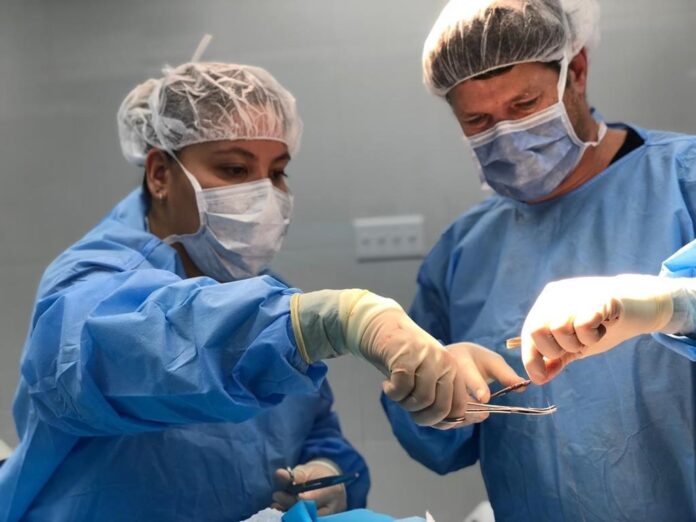Joanna Chan wants to come back to British Columbia to work as a physician assistant and she’s not alone.
The Canadian Association of Physician Assistants says a recent survey of its 800 members indicated 15 per cent want to work in B.C. It estimates that’s enough physician assistants to supply about 90,000 people with a primary care provider.
Read more:
Awareness campaign launched as thousands of Okanagan residents remain without a physician
However, the provincial government says despite the strains on the system, adding the new position isn’t part of its plans.
Physician assistants are educated under the same medical model used to train doctors but through a two-year graduate program. They can conduct patient interviews, provide physical examinations, perform diagnostic and therapeutic interventions, prescribe most medicines, order and read tests, and make referrals under the guidance of a physician.
Victoria health clinic shutting down, blames doctor shortage – Jan 17, 2022
Chan, 37, grew up in Vernon, B.C., but has worked in pediatric oncology at the Children’s Hospital of Eastern Ontario in Ottawa since she graduated from Hamilton’s McMaster University in 2014. She said she’s been hoping to return home since then but can’t until the province recognizes her profession.
“There’s a need for more health-care providers and there are tons of expertise that aren’t being leveraged,” she said. “There are huge gaps we could help fill.”
Their profession is regulated in Manitoba, Alberta, Ontario and New Brunswick, the Canadian Association of Physician Assistants says. Nova Scotia is near the end of a three-year physician assistant pilot project to address wait times. The military has also used physician assistants for over a century, though the term was only adopted in 1984.
Lisa Stewart, the B.C. director of the Canadian Association of Physician Assistants, said the pandemic and the opioid crisis have highlighted doctor shortages in the province and physicians assistants could be one solution.
“We can do about 70 per cent of what a family doctor can do, which means they help free up family doctors to see more complicated cases,” Stewart said.
“Our biggest barrier continues to be that we’re not considered a priority to be introduced and to be regulated.”
Health Minister Adrian Dix said Sunday that introducing physician assistants would require developing new programs to train them. Instead, he said the government’s focus is on doubling the number of nurse practitioners, who work in teams with doctors, dieticians and other care providers.
Trending Stories
Queen Elizabeth tests positive for COVID-19, has mild symptoms
Ottawa police arrest 191 as push to clear convoy blockade enters 3rd day
Looking for answers, and a solution, to the family doctor shortage in B.C – Nov 13, 2021
“We don’t exclude the idea of including physician assistants in that but our priority has been to increase the number of nurse practitioners,” he said.
He made the comment after announcing plans to add 602 new nursing seats to about 2,000 existing ones at public post-secondary institutions.
The Health Ministry said in a statement that physician assistants would not fill a role that nurse practitioners and associate physicians aren’t already filling. Associate physicians are doctors with medical training, often international medical graduates, approved by the College of Physicians and Surgeons of B.C. to work under physician supervision.
“Introducing a new classification of health-care providers requires a lengthy regulatory process, careful consideration and management to understand the implications on team function that would emerge from the overlapping scope of practice between physician assistants and current roles,” the emailed statement said.
The association said it has been lobbying the B.C. government to recognize physician assistants for more than a decade. It recently decided to follow Nova Scotia’s lead and requested funding for a physician assistant pilot project.
“That would be a great start to show how helpful we can be in addressing health-care needs,” said Stewart.
She said the proposal was submitted on Dec. 17, but they have not yet received a response.
UBC addressing Okanagan doctor shortage by training physicians in rural communities – Jan 29, 2019
Anthony Desloges, Ontario director for the Canadian Association of Physician Assistants, said one of the benefits the assistants provide is their ability to work in various specialties, which isn’t always an option for nurse practitioners or doctors.
Dr. Ramneek Dosanjh, president of the 14,000-member Doctors of BC, said the organization supports the use of physician assistants in the province.
“Crises always highlight the system’s weakest points and illuminates where we need to put resources. This is just one way to address the shortage of family doctors in our province,” she said.
Though it’s hard to quantify their impact, Kevin Dickenson, the president of the association’s New Brunswick chapter, said two physician assistants and a registered nurse see up to 40 per cent of the call volume at the Fredericton emergency department where he works.
“On days where we’re not there, the emergency department falls behind,” he said.
Chan said she’s seen the toll the pandemic and the opioid crisis are having on workers first-hand. She said she just wants to be able to help and give back to the community where she was raised.
“It really takes a whole bunch of people to help really sick people get better,” she said. “Each person and each profession bring something special to the table, and we just want to be at that table.”
This report by The Canadian Press was first published Feb. 20, 2022.
— With files from Amy Smart
© 2022 The Canadian Press



